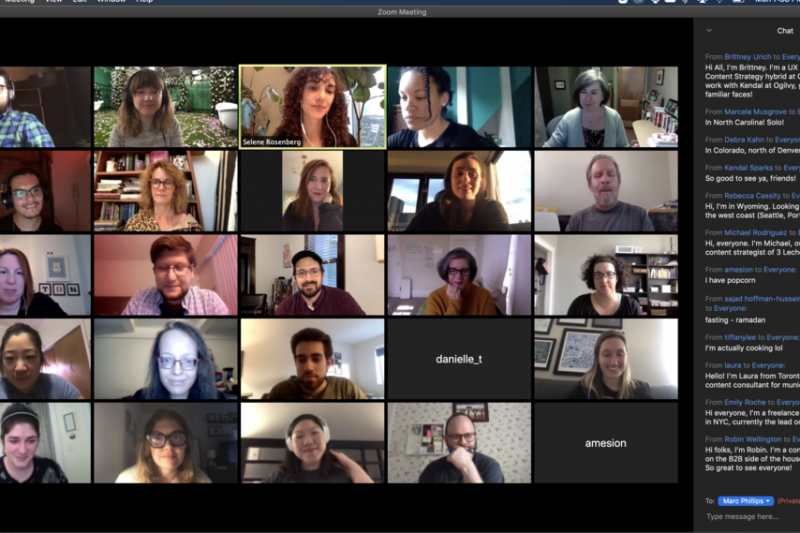
Since the start of our lockdown in March, my usual regimen of conferences to speak at and attend has all gone virtual, and the volume zoomed up exponentially.
I wanted to share what has worked well from those that I’ve participated in as both a speaker and an attendee, because I had the chance to see a little of the behind-the-scenes, as well as the attendee experience.
Information Architecture Conference, NYC UX Content Design Meetup, ASAE Membership, Marketing, and Communications conference, and the Confab Content Strategy Conference.
The first two were produced almost entirely by volunteers, while the others had paid staff. In all cases, they went virtual in a matter of weeks — an enormous upheaval for everyone involved!
Whether the experiences were excellent or had room for improvement, I want to honor the extraordinary efforts that each one made in creating an experience that kept the value from the in-person event and transformed what could be done in a virtual environment.
IA Conference
50+ sessions delivered three per day over two weeks, plus many game nights and social activities
Pluses: Lots of sessions, lots of organizers
Minuses: Too many platforms: Vimeo for sessions, Slack for conversations, Miro for interactive exercises, and Discourse for something else (not sure — I didn’t use the second two). Slack discussions were almost empty, because they were completely disconnected from the talks in time and channels.
NYC UX Content Design Meetup
A first virtual experience for this normally in-person event. I was supposed to present in person because it coincided with my NYC visit for another conference. When that other conference was cancelled, we decided together to try it virtually.
Pluses: Thanks to lots of good thinking in advance, there were interactive elements, and participants got to ask questions during and after the presentation. The hosts did a great job!
Minuses: None
ASAE MMC virtual conference
ASAE decided to turn its three-day in-person Membership, Marketing & Communications conference into a free one-day virtual event, with all the sessions focused on how Coronavirus affects association membership, marketing, and communications. The event drew 3,000 people — more than 5 times the usual attendance — and included an opening keynote talk and a handful of sessions.
Pluses: As a speaker, I was thrilled to co-lead a session for 750 attendees! It was so helpful to have a professional run the record and deal with the post-recording work to prepare it for onlien presentation. And as a participate, I found the interface for the sessions to be pretty straightforward and easy to use.
Minuses: No live host to tie the sessions together, keep people focused, or provide any engagement between sessions. The agenda had indicated that there would be brief transition sessions, but they did not happen.
Confab
Confab kept the dates and general structure of its conference intact as it transformed itself into a virtual event. With a lower price point, it drew more than 900 attendees, including many from outside the U.S. who would not have been able to attend. The in-person conference typically augments keynote presentations with breakout sessions from people with specific expertise in an organization or practice. The virtual conference also featured the types of fun, informal social events the conference is known for.
Pluses: Great live presence, from Kristina Halvorson as host to many engaging keynote presentations, panel discussions, and author Q&As
Minuses: The 18 on-demand library talks were almost entirely overlooked by attendees, with none getting more than 100 views during the conference. The Slack channels were so very popular that it was next to impossible to keep up with the conversations. Many (me included) felt that the social events should have happened in the evenings, keeping the prime conference time focused on professional learning.
Suggestions for virtual conference organizers
- Help people interact with all speakers in real time while watching their sessions, and immediately afterwards. This keeps the experience most like the typical conference setup, and even adds more interactivity among attendees. This often means having speakers record many or most sessions in advance. But don’t separate the talk and the interactions.
- Support speakers in their transition to record their talks. Ideally, have a person monitor the presentation and run the recording.
- Help people interact with each other, both socially and professionally, throughout the conference as you would orchestrate with an in-person event. “Hallway conversations” are often the most valuable part of conferences for attendees, so figure out how to re-create that spirit.
- Host the event: Have someone (or a small group of people) open the event and keep participants engaged in real time between sessions. The host(s) should have an engaging personality and positive attitude.
- Minimize the number of platforms: Ideally, the entire conference experience would be on a single platform, but that is not realistic at this time. Given that, it would be best to keep the conference to two platforms.
- Balance volume of sessions and number of days for the conference.
- My recommendation would be no more than 8 sessions in a given day, and no more than 4 days for the conference.
- If your conference would have had many more sessions than that, you can opt to run multiple tracks, allowing people to view the recorded sessions and chats of the other sessions if they choose.
- Alternatively, you might choose to reduce the number of sessions.

This Post Has 0 Comments